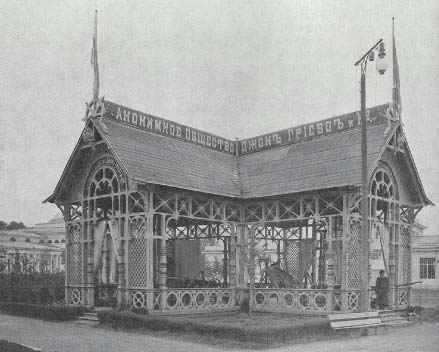English entrepreneurial capital was the first one judging by the time of activity in Ukraine and was associated with John James Hughes, the founder of the modern regional centre of Ukraine – the city of Donetsk. It was the Hughes’s plant of the Novorussian Society for Coal, Iron and Rail Production, established in London in 1869 that gave the name of a factory village – Yuzivka (“Yuz” is a Ukrainian approximation of Hughes), that later transformed into the city. In 1924, Yuzivka was named Stalino, and in 1961 the city was renamed into Donetsk.
The unique photos of the plant of John Hughes (since 2012 – CJSC “Donetsksteel”) have been preserved. John Hughes (1814–1889), a native of the city of Merthyr-Tydfi l, was a son of a metallurgist engineer. In 1860, Hughes became the director of the Millwall Iron Works that produced armor for covering of the ships. The imperial government offered Hughes to build a railroad production plant in the south of Russia. John Hughes travelled to Donbass, inspecting and studying the area and decided to build a plant in the deserted steppe. On May 29, 1869, the articles of the Company were adopted in London. 6,000 shares with 50 pounds sterling worthy for each were issued. It comprised the company capital of 3000,000 pounds sterling (1 pound – 9 rubles 46 kopecks).
Railway dealers, manufacturers of weapons, engineers that were well-known in Great Britain became the shareholders of the company.
John Hughes and John Vieret Guch were appointed as administrative directors. The design project of a new plant was developed in England. In 1870, eight steamships from South Wales with all equipment for the blast-furnace plant arrived at the Taganrog port.
From the port to the site of construction on the Kalmius River, the boilers and machine cars were transported in the transport trolleys by long horned bulls on the steppe roads through autumn impassable mud. About a hundred of engineers and workers, including first-class metallurgist Richards, came together with equipment from England.
The first cast iron was given by a blast furnace, filled on January 24, 1872. In 1873, the railroad plant began to work. In 1879, the production of manganese iron was started and the first melting of open-hearth steel was received. In the 1880s, the Hughes’s plant became the largest among those suchlike in the empire.
John Hughes moved to Ukraine together with his family, “subsequently he fell in love with his new Motherland, and sincerely wished the industrial success for it,” wrote the researchers of Hughes’s life. Mining engineer Mevius left his impressions of staying at Hughes’s plant:
“The impression made by this vast plant with its iron ways, numerous pipes, plenty of different furnaces, mountains of coal, coke, ores, cast iron and iron in various forms was very grand, especially when it is recalled that twenty years ago it was completely deserted here…“
 Hughes’s plant, a large capitalist enterprise of a combined type, was large even for European scale, and it was the only one at that time in Donbass, where almost seven thousand workers worked, bringing significant profits to its owners. In the year of John Hughes’s death – 1889 – his personal capital exceeded 10 million rubles.
Hughes’s plant, a large capitalist enterprise of a combined type, was large even for European scale, and it was the only one at that time in Donbass, where almost seven thousand workers worked, bringing significant profits to its owners. In the year of John Hughes’s death – 1889 – his personal capital exceeded 10 million rubles.
John Hughes’s grand plans for the enterprise development were embodied by his sons – John and Iver. Young Hugheses solved the housing problems of workers, moved football from England to the factory fields, arranged racecourses and the entertainment for workers during the holidays. The most famous creation of the Hughes’s plant had been “Mertsalov’s Palm”, forged in 1895 out of a steel rail by a smith, Oleksiy Mertsalov, and shown at many exhibitions, including the International Exhibition in Paris in 1900, where it was awarded with the Grand Prix. The image of the palm tree adorns the emblem of the city of Donetsk.
The second family business of the British was a joint-stock company of John Hriyevz, established in 1899 in Brussels. The “John Hriyevz and Co” сompany built plants of agricultural machinery and tools in Berdiansk. At the end of XIX century, an agricultural machine Production Company was considered the largest one in Europe. Today it is PJSC “Berdiansk Zhatki” (Zaporizhia region). The agricultural machines and tools were manufactured by the factory of the Oleksandrivsk Machine-Building Company, that was established in 1889, with the administration in London. Its factory was in the city of Oleksandrivsk (now Zaporizhia) in Katerynoslav governorate.
British citizen F. Biichcraft founded the Russian Carboniferous Society in 1899, with the capital of 360,000 pounds sterling for the activities in Slavianoserbsk district of Katerynoslav governorate.
The capital of the English-Russian Society of flouring mills, that was established in 1899, had its cost of 175,000 pounds sterling. The company purchased the V. Faust’s mills in Katerynoslav (now the city of Dnipro), and had been selling the products of production in the Empire and abroad.
According to the First General Population Census of the Russian Empire (1897), 344 citizens of Great Britain lived in Katerynoslav governorate.
The vast majority lived in the provinces of the governorate – 327 people, and only 17 people – in the cities of the governorate: in Mariupol – 9, Katerynoslav – 2, Luhansk – 2. In the governorate, the Vice-Consulate of Great Britain was opened and worked in the city of Mariupol. In 1913, Wilhelm Walton was the Vice-Consul.
Dmytro Pirkl, a co-author of the project “Foreign Investments in Ukraine. The end of XIX – the beginning of XX century.“ Valentyna Lazebnyk, Head of the Department of Dnipropetrovsk National Historical Museum named after D. Yavornytsky













